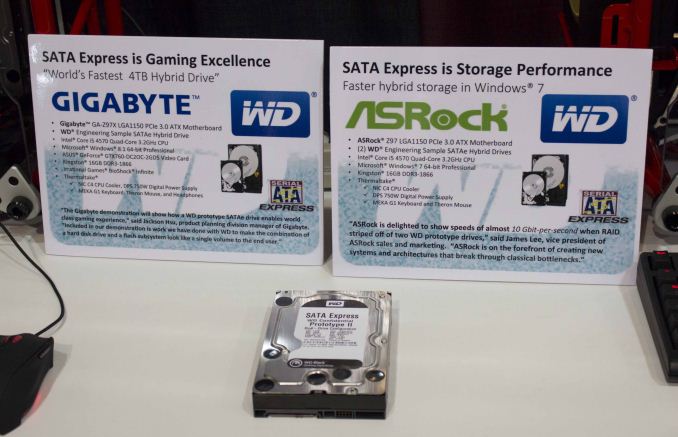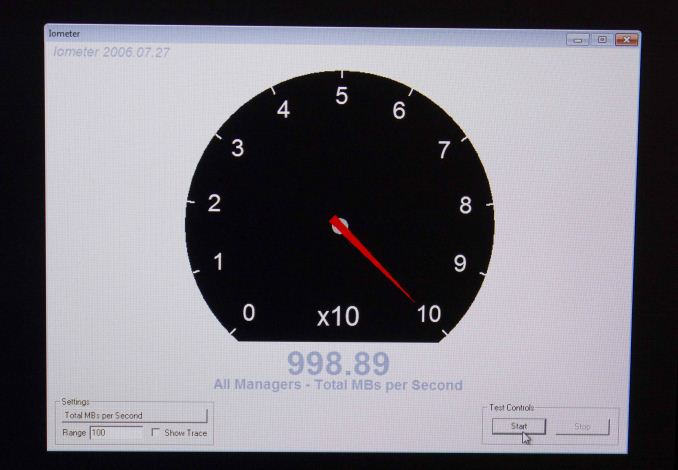Western Digital Shows Off a 128GB SSD + 4TB HDD 3.5" SATA Express Dual-Drive
by Kristian Vättö on January 4, 2015 9:30 PM EST- Posted in
- SSDs
- Western Digital
- CES
- Dual-Drive
- CES 2015

Storage Visions kicked off today and on the show floor Western Digital was showcasing a prototype of its new 3.5" dual-drive. The drive consists of a 128GB SSD along with a 4TB hard drive and utilizes PCIe 2.0 x2 interface through the SATA Express connector. Similar to the Black2 we reviewed last year, the prototype shows off as two separate volumes, although Western Digital is also working on a caching software to make the solution more user friendly. 2.5" version is also in the plans, although at first Western Digital is focusing on the 3.5" form factor.
Since the drive is in prototype stage, there are no specs available but since the drive is based on a JMicron SATA 6Gbps controller, the performance maxes out at ~550MB/s. At the booth, Western Digital was showing off two prototypes in software RAID 0 reaching 1GB/s, which is what you would expect from any two SATA 6Gbps SSDs in RAID 0.
Currently the product is more of a concept and there is no set release schedule, but the drive will likely appear on the market later this year. To be completely honest, the product as it stands today doesn't make much sense because it's internally SATA 6Gbps, but uses for PCIe for host connectivity. From a performance perspective the only advantage of PCIe is that the SSD and HDD can be accessed at the same time at full speed, but ultimately I think Western Digital has to go with a native PCIe SSD controller to be competitive. Western Digital told me that they are looking into PCIe controllers but since there aren't any available at this point, the prototype is stuck with SATA 6Gbps controllers.












18 Comments
View All Comments
d2mw - Monday, January 5, 2015 - link
People complaining about this being shit as a desktop drive may be correct in that assertion, but the form factor itself is very interesting. In a server scenario, it is quite common to desire bulk storage alongside fast storage, and having both in a single 3.5" unit this becomes very interesting.An example where this is very useful would be a large database server, where certain tables/indices may be hot (and suitable for SSD), whereas archival/bulk cold data could be stored on a separate magnetic-backed partition.
One option would be 1x 128gb SSD and 1x 4TB, but that means failure of either drive takes down the server. With a unit of this design, instead the failure sharded. With 2x(128gb+4tb) drives, with the SSD and magnetic parts put into separate RAID configurations, a 1U server suddenly saves a LOT of physical space to achieve a high level of reliability.
But on saying all that, often space sensitive server configurations also means 2.5" form factor.
iAPX - Monday, January 5, 2015 - link
On a server form-factor you won't use 3.5" hard drives except for archiving, and thus using 2 SSD as RAID-1 for caching.For live storage, you would use a RAID-5 or RAID-6 array (more preferably now a RAID-10) with 2.5" in SFF size-form, and maybe adding a RAID-1 of Server SSD for your DB, all with SAS interface through a RAID card that have a battery.
I don't see cases to use SATA 3.5" hard-drives on servers, except if you do your own trick (and in this case you don't need integrated SSD, you will prefer another cache level using other SSD), and I know it fro mexperience ,I have done it for a file sharing website. (was Technical director and associate)
nils_ - Tuesday, January 6, 2015 - link
I see 3.5" all the time in the server space. These drives would make an interesting choice for ceph OSD, put the journal on SSD and the data on HDD. Saves a bit of space.nils_ - Tuesday, January 6, 2015 - link
Although SATA Express is a deal breaker.MrSpadge - Monday, January 5, 2015 - link
Finally a high-end hybrid drive! If this implements caching transparent to the OS, like Seagates solutions, it could be of tremendous value for entry-level servers. As far as I know Enterprises charge a lot for SSD caching, whereas client solutions are limited to caching single disks. But with these one could simply put 4 of them in a Raid 5 (or what ever you want) and get an automatic large SSD cache. Although Server 2012 R2 already introduced some SSD-awareness to storage spaces.. but I don't know how good this is.For my current desktop I'll continue to use Intel SRT with my 60 GB Agility 3, though. Later I could see myself upgrading to a real PCIe M.2 SSD with 256 GB and use 60 GB as HDD cache and 180 GB as OS partition.
Gigaplex - Monday, January 5, 2015 - link
How do you put 4 of these in a pool? They're SATA Express, systems generally don't come with more than one or two of these ports.nils_ - Wednesday, January 7, 2015 - link
Linux device mapper could do all those things independent of RAID controllers etc..TrackSmart - Monday, January 5, 2015 - link
Does anyone else think they are 2-3 years behind the times? I wanted this 2-3 years ago, in laptop form factor, with actually intelligent software to manage what stays on the SSD (i.e. entire OS + most programs + recent documents). But they STILL don't have a laptop hybrid drive that offers truly SSD-like performance.And they have now missed the boat. I don't need a product like this anymore when I can get a 500GB SSD for around $200 without even waiting for a sale.
By the time their mobile solution comes out, large SSDs will be even cheaper and this will be a solution strictly for the low-end of the market. A huge opportunity missed by Western Digital to bridge the gap between price, performance, and storage capacity.